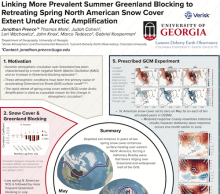Linking More Prevalent Summer Greenland Blocking to Retreating Spring North American Snow Cover Extent Under Arctic Amplification
Jonathon
Preece
University of Georgia, Department of Geography
Poster
Meltwater runoff from the Greenland Ice Sheet has rapidly accelerated in recent decades. A major contributor to this surface mass loss has been the pronounced increase in the incidence of high amplitude, quasistationary anticyclones, known as atmospheric blocks, which promote extensive melt of the ice sheet by delivering warm, moist air from low latitudes. The rapid retreat of spring snow cover under Arctic amplification represents a substantial change in the surface thermal forcing of the lower atmosphere with the potential to alter large-scale atmospheric flow. Here, we investigate the link between shrinking snow cover extent and the rise in Greenland blocking. Using atmospheric fields retrieved from the ERA5 global reanalysis and snow cover area provided by the Rutgers University Global Snow Lab, we document a statistically significant (α=0.05) lagged correlation indicating an increase in July Greenland blocking in years with low spring North American snow cover extent. We then trace the atmospheric response using the three-dimensional wave activity flux and show that this statistical relationship reflects a July stationary wave response that accompanies the early depletion of soil moisture and attendant anomalous heating of the lower atmosphere over Eastern Canada in years of low spring snow cover. To complement our observational results, we conducted a model experiment in CESM2, wherein we compared a 10-year control simulation with a “no snow” simulation of the same 10 years in which we altered the restart files to reduce North America snow cover to zero on May 1 of each year. The difference between the control and no snow simulations reveals a stationary wave response that closely resembles that in the reanalysis data, albeit a month earlier in June. Considered together, these results present corroborating evidence of a link between Arctic amplification and recent dynamical forcing of Greenland Ice Sheet mass loss.

preece-jonathon-polar-poster.pdf
(5.85 MB)
